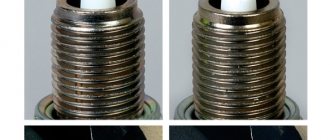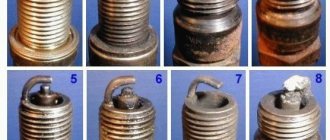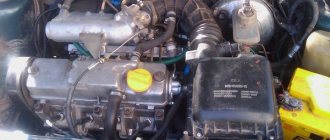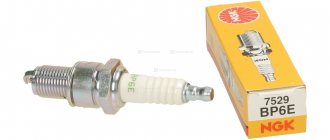What to do if the spark plugs are flooded?
Every motorist knows that if the car does not start the first time, it will be much more difficult to do so the second and third time, but not everyone knows that the problem at such moments quite often lies not in a dead battery, but in flooded spark plugs. This article will tell you what floods them, why and what to do in such situations.
Why is good compression and rapid compression of the mixture important?
The process of combustion of the air-fuel mixture in cylinders
In order for a flash of the air-fuel mixture to occur, it must be compressed, and this must be done quickly enough - then the mixture will heat up and will be heated steam, only instead of water, it will contain gasoline as moisture. Such a mixture does not settle as a conductive film between the electrodes of the spark plug, and the spark discharge will not “go to ground”, but will ignite the mixture, which is also heated by compression.
Good compression in the cylinder ensures rapid compression and heating of the air-fuel mixture.
In the case when the compression stroke occurs slowly, the pressure in the cylinder will not become sufficient - the compressed mixture of gases will be released through the gaps between the parts. In addition, the thermal energy acquired by the mixture will be completely inappropriately used to warm up the metal parts, and gasoline in liquid form will be “delivered” to the electrodes of the spark plug and will safely flood it. A person who has at least once inflated bicycle wheels with a pump without a plastic coating on the cylinder can imagine this very clearly. If you pump intensively, the pump body will become very hot, and the proportion of its heating due to piston friction will be only a small part. This is easy to verify if you run the pump “idle” - without screwing the hose to the spool - the pump body will hardly warm up even after fifty cycles. So, why dynamic compression of the mixture is needed, and how it, in combination with good compression, favors the flash of fuel, we found out. But do not forget that in cold weather:
- battery energy decreases;
- The engine oil thickens, making it difficult for the starter to crank the crankshaft. The starter begins to consume more energy, which is also needed for a powerful spark.
All this happens without proper dynamics. It turns out to be a “vicious circle” - and the candles are filled with gasoline. All of the above can give a clear answer to the question: “can the spark plugs on the injector be filled in in cold weather?” Of course it can.
Checking compression in the cylinder with a compression gauge
There can be several reasons for low compression in the cylinders. When measuring compression, a compression meter is used.
But it happens that the candles are filled with oil. This is a separate case - engine repair is required. For initial diagnostics of the engine (not its control systems, namely the timing and timing gear mechanisms), you can use a compression meter. You measure the compression - the norm for a gasoline engine is 12 kg/cm2. If its value is significantly less than 10 kg/cm2, pour 30 - 50 grams of oil into the spark plug holes. If the compression has risen, repair the piston-cylinder pair, and this is already a “capital”. If the compression does not rise after filling the oil, there is a violation of the tightness of the combustion chambers - the valves do not fit tightly to the seats, they burn out, etc. If the values are the same, most likely the oil seals on the valve guides or the oil control piston rings are worn out. The rings, however, can “get stuck” in the piston grooves.
Possible solutions to the problem of flooded candles
The manufacturing plant has already foreseen the situation in which the spark plugs splash, and VAZ, for example, has the corresponding instructions in its passport. Basic recommendations for actions if fuel gets on the spark plug, which is called “cold”:
- Remove the candles.
- Crank the starter for 15 minutes without spark plugs.
- Wipe and dry the spark plugs well, then install them in their original place.
We recommend: In what cases should we use a molybdenum additive?
There is an alternative, so-called “folk” method. It must be applied even before the spark plugs are removed:
- Press the gas pedal all the way.
- Crank the starter for 10 -15 seconds.
- Return the pedal to its place.
Since at this moment there is no supply of fuel mixture, the spark plugs are purged and dried with air. If all else fails, remove the wet spark plugs and dry them thoroughly. Depending on the conditions, you can dry it over any heat source - fire, gas stove, hairdryer.
Calcination shortens the life of candles, so you should not heat them for a long time. After drying, the gap must be checked; if necessary, the gap is adjusted and the spark plug is installed in its place. If everything is done correctly, the engine should start.
Injection and carburetor spark plugs are practically the same, so the methods used can be used in both cases. If the spark plugs on the injector are flooded in the warm season, diagnostics of the fuel system and the sparking mechanism is necessary. If necessary, it is necessary to replace faulty components. At the same time, the condition of the injectors is checked, as well as the functionality of the Hall sensor.
The main reasons why spark plugs flood lie in non-compliance with the terms of preventive maintenance and technical regulations. Prevention can significantly increase the period of trouble-free operation of vehicle components. Therefore, even before the onset of frost, a number of preventive measures should be carried out:
- Constantly monitor the condition of the battery. In winter, it is generally better to install a battery with a higher capacity than was used in the warm season. With a powerful battery, a number of reasons for allowing fuel to flood the spark plugs disappear. It is best to recharge the battery at night, but in compliance with fire safety rules;
- During cold weather, increased attention must be paid to engine oil, and high-quality gasoline should also be filled, without contaminants. Consumable lubricants must be appropriate for the season;
- You must constantly monitor the condition of the spark plugs. It is necessary to regularly unscrew the spark plugs, remove carbon deposits from them, clean and adjust the gap. If technical characteristics deteriorate, it is best to replace the spark plugs.
What to do to prevent candles from flooding
There are several recommendations that will help minimize the occurrence of such problems:
- firstly, you need to monitor the battery charge level and periodically recharge it (this is especially true in winter);
- secondly, check the serviceability of the starter and if any problems arise, do not be lazy to go for diagnostics;
- thirdly, fill the engine with only the best quality oil, which is suitable for use in winter;
- fourthly, change spark plugs in a timely manner and inspect high-voltage wires for the fact of their probable failure;
- fifthly, adjust and clean the injector nozzles. This is easy to do - add one of the special compounds that are sold in stores to the tank;
- sixth, use high quality automobile fuel. To do this, refuel at trusted gas stations.
Remember that in the cold season the engine does not like small trips at low speed.
Therefore, in order to avoid problems, it is necessary to drive 50-80 kilometers at a time at least once a month and accelerate the car to 90-110 kilometers per hour (if, of course, road conditions allow).
If this is not possible, then periodically, while driving, increase the engine speed to 4-5 thousand revolutions. This is an excellent method for removing excess deposits and carbon deposits.
It’s important to read about the reasons why the car won’t start.
Self-cleaning of the engine occurs due to strong pressure. You can clean the engine by running it in the morning at five thousand rpm for 10 minutes. The effect is similar to driving along a highway.
Monitor the condition of your car, then you will avoid unpleasant situations and save your nerves.
Spark plugs, which causes the spark plugs to prime
As a rule, it all depends on the condition of your vehicle's battery and the device of the car - an injector or a carburetor.
The main culprit for this problem is a weak battery. At low temperatures, it does not create the necessary voltage on the engine spark plugs; the spark is weak and cannot ignite the fuel. As a result of this, gasoline begins to flood the spark plugs. This is why in winter it is so important to systematically check the condition of the battery.
The injector is a more progressive, but also more complex system. At low temperatures, the on-board computer forces the injector nozzles to supply more fuel to the air mixture to enrich the composition. But if the vehicle's battery is weakly charged, the spark is not enough to ignite the fuel, resulting in the spark plugs flooding at the injector. But filling the injector is not so easy. Unlike carburetor engines, injection engines have many sensors that monitor the engine and fuel supply. If the vehicle does not start, fuel is not supplied in large volumes, which minimizes flooding of spark plugs. It is worth noting that if the vehicle does not start the third time, you should wait a little and try to start it again. If it doesn’t work again, you will have to charge the battery and clean the spark plugs.
The carburetor is a simple, but already quite outdated fuel injection system. An incorrectly adjusted carburetor is capable of pouring fuel into the combustion chambers, and if this still works in the warm season, then in cold weather the excess fuel simply floods the candles. Accordingly, starting a vehicle with a carburetor engine is virtually impossible. In addition, the carburetor does not have a fuel supply measure. In other words, if you haven’t started the car, it will still pour fuel in the volume for which it is configured. Therefore, before the onset of winter, you should definitely adjust the carburetor, otherwise starting the engine at very low temperatures will not be easy.
Why are the candles wet?
Sometimes a removed spark plug may be wet. This may be caused by gasoline, oil or coolant (antifreeze). Each of these liquids has its own determination methods.
We recommend: How to remove the front and rear bumpers on a VAZ 2110
Gasoline can be easily identified by its high volatility. By unscrewing the spark plug, the gasoline quickly dries out. Most often, filling with gasoline occurs when starting a cold engine. This can also happen due to incorrect ignition adjustment.
Oil on the spark plug electrodes may appear due to significant wear of the oil seals in the valves. Less commonly, the cause may be wear of the engine cylinder-piston group or breakage of the oil rings on the piston. Any of these faults requires immediate repair.
The amount of oil on the spark plugs can indicate how serious the problem is. When diagnosing, it is best to use a set of new spark plugs recommended by the car manufacturer, since droplets of oil are clearly visible on a clean insulator. The first stage is the appearance of small dark spots from burnt oil. This will not affect the performance of the spark plug in any way, but will indicate that there are still problems with the engine. The next stage of oil entering the combustion chamber will be the moistening of the lower threaded part of the spark plug. This condition of the spark plug will cause popping noises in the muffler at idle. They disappear as the engine speed increases.
Next is coating the end of the threaded part of the spark plug with oil. In this case, a spark may not appear. The result is frequent claps in the muffler.
The last stage is the complete wetting of the candle from below. In this situation, a spark does not form at all. Therefore, a cylinder with such a spark plug does not work. You can find out about this by regular claps in the muffler, which do not stop with increasing speed. The engine starts to stall.
If oil enters the combustion chamber with completely working fuel supply and ignition systems, then its combustion occurs on the electrodes of the spark plug. As a result, the oil does not have time to wet the candle. That's not to say it's good, but it's not too bad either. In this case, droplets of burned oil turn into ash. It accumulates on the electrodes, increasing their thickness. When the engine is running, the ash warms up well. This promotes further combustion of the incoming oil. It is easy to clean, but it is better to do this at the same time as replacing the valve seals. If you remove the ash from the candle, the oil may stop burning. Because of this, the spark may stop jumping, the spark plug will flood, and the cylinder will stop working.
Sometimes “traditional craftsmen” use the following methods to combat flooding of candles: install candles with a shorter skirt or with a higher heat rating, increase the spark voltage by putting on high-voltage tips, leaving a small gap. All these methods are short-lived, ineffective, and are dangerous for the condition of the car.
The reasons for the ingress of coolant may be the following: a poorly pressed cylinder head, a crack in it or in the liner body, a leaky carburetor heating system. As for the last reason, it is typical only for Japanese cars.
In practice, it is difficult to determine whether antifreeze enters the combustion chamber, since when the engine warms up, some holes may close as a result of metal expansion. Diagnostics must be carried out on a cold engine. To do this, you need to start the car for about 10 seconds. During this time, the candles will not have time to heat up and the cracks will not disappear. When the spark plug is removed, the coolant looks like dew drops.
When buying new spark plugs, you should be wary of counterfeits, as they can cause the entire engine to fail. They can be identified by a crooked or uneven inscription, poor-quality processing of the hexagon of the candle, or poorly executed packaging.
Why does the spark plugs fill when they are hot?
This type of malfunction, such as pouring spark plugs when they are hot, rarely occurs. Basically it happens like this: the engine started well when cold, heated up to the set temperature, drove for some time and suddenly stalled. Next, when you try to start the engine, the starter turns properly, there is gasoline, but the car does not want to start. Then, if you do nothing and leave it for a long time, the engine starts easily again. This is a sign of flooding of candles.
We recommend: How to make a heated windshield with your own hands
Reasons why spark plugs flood when the engine is hot:
- The spark plug itself is faulty (broken; the gap is either large or small;).
- The carburetor (if equipped) is not set correctly.
- Problems with the distributor (if any).
- Faulty wiring.
- Faulty sensors (mass air flow sensor).
- The high-voltage wire is broken.
- Malfunctioning injectors.
- Problems with the software (controller or firmware).
- Operating a car with a carburetor engine with an extended choke for a long time.
The way to solve the problem of flooding spark plugs in carburetor engines is to make sure that the fuel-air mixture is lean, to do this, purge for up to 10 seconds.
A way to solve the problem of flooding spark plugs in injection engines is to blow out the cylinders by opening or partially opening the throttles.
Let's decide what this means and why it happens?
It's no secret that an internal combustion engine is a rather complex device in which several sequential processes take place. The first process is the supply of a fuel-air mixture, during which fuel is mixed with air and enters the engine cylinders. The second is the compression of the said mixture by the cylinders, by raising the piston as high as possible with the valves closed. The third is ignition: a spark is supplied to the cylinders, where the fuel-air mixture is under pressure, provoking a mini-explosion, ignition of the said mixture and the downward movement of the piston. The fourth process is the release of exhaust gases through a piston and valves into the gas exhaust system.
This is how the internal combustion engine operates under normal conditions, but in winter (in the cold) failures may occur in this sequential cycle.
Due to the fact that cold air is much more enriched in oxygen than warm air, a larger volume of fuel is required to ignite it. The ECU knows about this and sends the appropriate command to the injectors. They, in turn, send an upwardly adjusted amount of fuel into the combustion chamber, where at this time the starter tries to simultaneously create good compression and give a spark to generate a flash. Taking into account the poor quality of gasoline at our gas stations and the presence of some wear and tear on parts (we are not talking about new cars here, since the compression in them is ideal, so the question: the spark plugs are flooded, what to do? - it’s simply not worth it), it’s good to do it He doesn't always succeed. As a result, the mixture does not ignite, and the fuel supplied to create a chemical reaction floods the candles, completely paralyzing their work. This can happen for only 2 reasons:
- due to an overly simple and already outdated injection system in carburetor engines, in which there is no measure of fuel supply (even if the car does not start, the system will continue to “pour” gasoline in the amount “prescribed” in the settings), as well as its incorrect settings;
- (found on both a carburetor car and an injector) due to a weak battery, which at low temperatures is simply not able to create the necessary voltage to ignite a spark.
It is therefore obvious that in order not to be left without a means of transportation in winter, when preparing your car for the winter season, be sure to check its battery and carburetor settings (if your car is equipped with one).
Let's sum it up
Taking into account the above, it becomes clear that for normal starting and operation of the engine it is necessary to create certain conditions. It is also important to remember that increased requirements are put forward in winter. In an effort to achieve a stable start, novice car enthusiasts often ask which spark plugs do not fill. You can immediately answer that in the event of a malfunction, any spark plugs will flood, even new ones. This happens regardless of the brand, the condition of the candles themselves, design features, brand, etc.
Please note that to prevent gasoline from flooding the spark plugs, you must:
- monitor the battery charge, recharge the battery using a charger;
- the starter must be in good working order; jamming, slipping, etc. is not allowed;
- The engine must be filled with oil that corresponds to the current operating conditions (viscosity suitable for winter, as well as other parameters);
- The power supply system must be absolutely in good working order, the injector nozzles must be cleaned in a timely manner. For cleaning, it is advisable to resort to more effective methods of cleaning injectors with ultrasound or to wash the injector on a special washing stand, and not limit yourself to just preventive additions of various cleaners to the fuel tank;
- It is advisable to refuel only at proven gas stations that have certificates confirming the quality of the fuel;
- regularly check the condition of spark plugs and high-voltage wires;
In order to prevent carbon formation in a working engine, experts recommend periodically spinning the power unit to high speeds (about 4500-5000 rpm), after which you need to drive at least 30-50 km in this mode. This is especially true for cars that are constantly used in urban environments. Factors such as: prolonged operation at idle, short trips in low gears, low revs and driving at low speeds, underheating of the engine (the unit does not have time to fully reach operating temperature) lead to increased accumulation of carbon deposits and engine coking. Increasing the speed and load above the average level allows for partial cleaning of soot and deposits in the combustion chamber of the internal combustion engine in a natural way.
What to do if the spark plugs are flooded and how to start the car?
Replacing spark plugs
How to understand what has flooded the candles? By unscrewing them from the block head, the electrodes will be covered with moisture. But if the spark plugs are flooded in winter, including on the injector (injection engine), and there is no desire to “digging” in the engine in the cold, you can “blow out” the combustion chambers.
Often, “ventilating” the combustion chambers by starting the engine and depressing the gas pedal is quite enough to dry the spark plugs.
If the spark plugs are flooded and the car won’t start, there is no point in waiting for them to dry out. It is necessary to remove excess fuel from the chambers. The procedure is simple - press the gas pedal all the way, turn the engine with the starter for 10 seconds, release the pedal and try to start the engine. Cranking the engine with the throttle valve fully open “ventilates” the combustion chambers and dries out the spark plug insulators. But this method is good in cold weather and if the battery is in perfect condition. The most sensible thing to do would be to unscrew the candles, wipe them and dry them with an open flame - possibly on a gas stove. In such a case, of course, it’s a good idea to have a spare set, even if it’s not new, but still functional. The combustion chambers can also be cleaned by cranking the engine. With the spark plugs turned out, the load on the battery is significantly less. Unscrewing the spark plugs is also good because you won’t rack your brains trying to figure out what’s wrong with the engine—whether the spark plugs are filled with gasoline or something else has happened—for example, the fuel pump has failed.
We recommend: 9 best spark plugs
What to do in this case?
Press the accelerator pedal all the way and turn the key in the ignition.
Crank the starter for 8-10 seconds. At the end of this time, the pedal can be returned to its original position.
In most cases, the engine starts.
The peculiarity of this method is that when the gas is fully pressed, the fuel supply to the engine is shut off, and the spark plugs themselves are blown exclusively with air.
If the engine still does not start, then you need to dry the spark plugs.
Why does fuel flood the spark plugs in the injector?
If the spark plugs are flooded, then among the reasons, the condition of the piston system should be put in first place, because with ideal compression, the engine should start even with minimal spark values. However, only a new car can have such compression, while a used car already has some wear and tear. After only three years of operation, a VAZ car begins to suffer from this disease when fuel enters the injector.
It should be remembered that the spark plugs can be filled on both the carburetor and the injection engine. The fuel system does not affect this situation.
It is typical that fuel can get onto the spark plugs in winter even in serviceable cars as a result of the system’s interaction with cold air. But in the summer, this problem in the vast majority of cases occurs if something is wrong with the car. The ignition control unit malfunctions - when a command is given to increase the fuel in the injectors, the fuel supplied in a large volume does not have time to ignite, hence wet spark plugs and other troubles. This applies to injection engines; for carburetor cars, in the absence of an ECU unit, this situation arises due to insufficient compression, and this directly depends on the condition of the piston group.
It is worth mentioning another problem when the spark plugs are stained with oil and the engine operation is inconsistent. There is an increased waste of expensive oil, problems with idling and “triple” of the engine. Among the reasons, we can name, first of all, the same wear of the piston group, increased oil pressure in the crankcase, failure of the valve stem seals and cuffs.
Fills candles with gasoline: reasons
The injector fills the spark plugs with gasoline due to the characteristics of the engine control unit. It is usually clear why the spark plugs on a VAZ 2110 or any other similar car flood during frosts. Going forward, we can say that the main reason why spark plugs are filled with gasoline is negligence and a discharged battery.
In order for the engine to start in cold weather, the engine control unit needs to supply more gasoline to the combustion chambers, because there is more oxygen in cold air, so more gasoline is needed. As a result, more fuel mixture is obtained, and the car usually drives more quickly if everything works well.
The engine's electronic control unit gives a signal to the injector nozzles to increase the fuel supply. They usually cope with this normally, if they work properly.
But if your battery is far from new, and in the cold the battery discharges faster, then a situation may occur in the engine when the injectors drive gasoline into the combustion chamber, and the starter creates the necessary compression in the cylinders, at this moment a high-quality discharge must appear for it to occur. flash. Also, a lot depends on the quality of the fuel, and high-quality fuel does not exist in nature in Russia.
As a result, it turns out that if the engine has ideal compression, and this only happens in a new car, then the injector spark plugs will be able to start the engine with the minimum permissible impulse. And if the car is not new and the battery has also become weak in the cold, then eventually the spark plugs will give a weak spark, and the injectors will supply fuel to the combustion chamber at full capacity, so the spark plugs will begin to flood, and they will finally stop giving a spark. This is why the injector floods the spark plugs because the battery is discharged. Therefore, if you have flooded the spark plugs in your VAZ 2114, then you know why this happened, and now we’ll find out what to do about it.
Spark plugs, the influence of weather conditions on the operation of the ignition system
We all know that when working in an internal combustion engine, a number of processes occur:
- Supply of the fuel-air mixture - fuel is mixed with air, and then supplied to the engine cylinders.
- Compression of this mixture by the engine cylinders - the valves are closed, the piston goes up and reaches the maximum point.
- Ignition - a spark is supplied to the spark plugs, as a result of which this compressed fuel ignites, a minimal explosion occurs, after which the piston moves down.
- The exhaust gas outlet is when the burned fuel leaves the engine piston through valves and the gas exhaust system.
When the weather is frosty outside, ignition does not always occur. In other words, the combustible mixture (air + gasoline) enters the engine cylinders, but does not ignite. Thus, fuel floods the candles, which become wet, and the formation of a spark on such candles is virtually impossible. If the spark plugs are wet, and the driver continues to “turn the engine,” this only aggravates the situation, since the spark plugs become even more wet from gasoline.
Studying plaque on candles
They say that when candles are “flooded,” black soot forms. Let us clarify: it should not consist of inclusions. All metal, in turn, will be covered with an oily coating. Dry carbon looks different...
Oily layer and dry soot
The photo shows two cases. “Our version” is on the right.
We recommend: Full description of tire markings
And soot can also be brown. And it always, in 100% of cases, is formed due to flooding with gasoline.
Dark brown soot
An oily coating, as in photo 1, is, nevertheless, the result of oil ingress. But an oiled candle does not work correctly - it will also be “flooded”.
With regular “flooding,” carbon deposits form, which we see in photo 1 on the right and in photo 2. The rest does not apply to our case.











